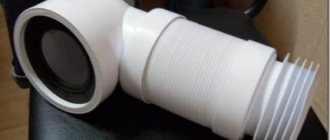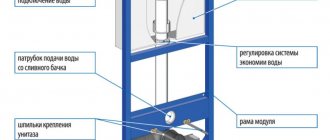What to do if the toilet tank is leaking? A device malfunction may be caused by damage to one of the design components. In most cases, operation is disrupted due to a malfunction of the siphon, fasteners, locking mechanism, rubber bulb or gasket.
Sometimes a toilet leaks due to physical damage to the tank or bowl of the plumbing fixture.
Such malfunctions can bring a lot of trouble to apartment residents, so it is recommended not to delay repairs.
You can carry out the repair procedure yourself. In this article we will analyze in detail the reasons causing this malfunction and methods for eliminating them.
Water flows in the toilet after filling the tank
The design of toilet flush tanks is based on the principle of filling the vessel with tap water until the water supply valve is activated, which blocks its flow into the tank.
One of the safety devices in this system is the overflow mechanism: when the tank is filled, if the shut-off valve does not operate and water continues to flow into the cavity, the excess volume of water flows by gravity into the toilet. The situation when, for some reason, the inlet valve does not close is not the most critical, unless you take into account that even with the toilet not working, water consumption increases to an average of 100 liters per day.
The reasons for water overflow can be:
Incorrect adjustment of the float mechanism of the flush tank
Overflow due to improper adjustment of the float mechanism is the most common problem in flush tanks. The float chamber, pushed by the volume of water through a metal rod or plastic guide, presses on the valve and thus stops the flow of liquid into the tank. If the metal guide is bent or the adjustment screw on the plastic guide is loosened, the float chamber moves and the supply valve simply does not shut off the supply.
The method to solve the problem is simple: remove the tank lid and adjust the position of the float relative to the upper water level. For most toilets, the float is adjusted so that the water level does not reach the overflow neck by 1-1.5 cm.
Float chamber malfunction
If the float is damaged, the supply valve simply does not close. A float filled with water does not float up and thus the supply valve is simply constantly in the open position.
The simplest repair method is to replace the float or drain the water from it and seal the leak.
Water supply valve diaphragm malfunction
For diaphragm water supply valves, the supply is closed by pressing the plastic rod onto the rubber membrane, while the supply hole on the reverse side is tightly blocked by the rubber. Over time, a groove forms on the rubber at the inlet hole, through which water first begins to simply seep through, and after a while it simply flows unhindered into the tank. The repair method is membrane replacement.
Drain mechanism malfunction
This problem begins to manifest itself gradually when the tank itself, after a certain time, begins to fill with water. In this case, it is necessary to disassemble the drain mechanism, clean it of deposits and change the rubber seals.
Poor water quality
The reason for the tank overflowing is often associated with poor-quality tap water - a large amount of iron oxide, lime or mechanical inclusions form a coating on the walls and mechanisms, which over time acts on the rubber seals as an abrasive, literally eating the surface. In this case, it is necessary to install a filter system and replace rubber gaskets, membranes and seals.
Causes of liquid snot are pathological
The main causes of excessive fluid flowing from the nose:
- inflammatory processes of an infectious nature;
- rhinitis;
- different forms of sinusitis;
- sinusitis;
- allergic reactions.
A few examples of reasons why there may be liquid snot
- If the snot flows constantly, a burning sensation appears in the nose, these are the first signs of a cold. After some time, the liquid discharge acquires a thick consistency, making nasal breathing difficult. The duration of the disease is no more than two weeks.
- Quite often, a runny nose appears as an independent symptom, for no apparent reason. This means that the person has been in the cold for a long time. No special treatment is required; such snot is a protective form of the body and goes away on its own.
- If fluid flows from the nose when tilted down, you need to consult a doctor, as this is a symptom of a serious pathological process - a maxillary cyst.
- If snot flows during a certain season and a runny nose is accompanied by sneezing, this indicates an allergic reaction. The easiest way to get rid of unpleasant symptoms is to identify and eliminate the allergen. Additionally, the nasal passages are washed and nasal medications are used.
Water flows into the toilet after flushing
The problem associated with water leakage after flushing occurs both in old-style systems with cast-iron wall-mounted tanks and in new “compact” systems. The reason for this phenomenon is the improper operation of the flushing mechanism.
When you press a key or button, water is discharged and the drain hole opens as wide as possible. At this time, the locking and adjusting mechanisms are in a suspended state - when the button is pressed, the valve or weight with the gasket cannot lower, but as soon as the button is released, the mechanism returns to the lowest position and closes the drain neck.
A sudden release of the button causes the locking mechanism to move along the guides under the influence of the water flow. At the same time, the deterioration of plastic parts becomes more and more visible, this leads to distortions and “freezing” of the mechanism itself. The result of such a defect is the following: the drain neck is skewed and incompletely closed; the water entering the tank is simply immediately drained into the toilet.
The method of troubleshooting is to completely replace the drain mechanism and then adjust its operation:
One of the additional causes of the problem may be increased water hardness and the natural aging processes of plastic.
Self-repair or inviting a specialist?
Most of the problems that result in the toilet leaking from below after draining the water or other difficulties arise can be easily solved independently. This requires only minimal skills in working with tools (wrench, screwdriver, sealant) and an understanding of the device diagram. The diagram is usually supplied complete with a compact toilet; in addition to the names of the parts, it indicates the assembly sequence.
By saving the diagram and assembly instructions, you can disassemble the tank fittings at any time and fix the problem.
Important: if you need to replace parts, it is advisable to contact a specialized store (construction market sellers), having in hand this part, a description of the malfunction and the exact name of the toilet model (cistern). In this case, the correct choice of structural element is more likely.
By inviting a technician, the bathroom owner gets rid of the need to personally find out the cause of the leak, look for a replacement part, or repair the device. However, the called specialist does not necessarily come immediately and cannot always immediately understand the problem. In addition, the work of the master must be paid.
Thus, depending on your own qualifications and self-confidence, the question of how to fix a leak in the toilet is decided in favor of calling a specialist or doing the repair yourself.
The tank is leaking where the bolts are attached
Installation of compact type toilets is carried out using a bolted connection between the tank and the toilet. In this case, the most common bolts are made of metal with a zinc coating to protect against corrosion. Rubber gaskets and universal silicone sealant are used as sealing. In more expensive models, the bolts may be made of brass or bronze, but in most cases it is galvanized metal, which is still susceptible to corrosion.
Leakage at bolted joints begins with a small amount of water seeping in, and gradually the leakage will increase. The following can be suggested as preventive measures:
- Shut off the water supply.
- Drain the water from the tank.
- Carefully loosen the thread.
- Remove the bolts.
- Remove rubber gaskets.
- Clean the surface of the rubber gaskets from silicone and dry them.
- Clean the ceramic surfaces where the bolts are installed.
- Apply a layer of silicone sealant and install rubber seals.
- Again treat the seat of the bolted connection with silicone, install the bolts, add 2-3 metal washers from below and tighten the connection with a nut.
If the leak cannot be stopped, the entire fastening system must be replaced, from bolts to rubber seals. In this case, there is no point in trivializing; everything needs to be changed.
Types of pathology
Doctors distinguish types of incontinence based on symptoms:
- Stress urinary incontinence caused by increased intra-abdominal pressure with:
- performing sports exercises;
- carrying heavy objects;
- sneezing;
- cough;
- nervous tension;
- fit of laughter;
- sexual contact.
- Urgent incontinence. It manifests itself as such intense urges that sometimes a woman does not have time to respond to them. In this case, an overactive bladder is not at all full. Urge incontinence is characteristic of inflammatory diseases of the bladder.
- Paradoxical ischuria is a pathological phenomenon when, with maximum overfilling of the bladder, difficulty arises (usually of a psychological nature) to empty it. Urine is spontaneously released in separate drops from the urethra.
- A mixed form is considered a pathological condition in which individual symptoms of the first two types are present.
- Incontinence can be caused by anatomical features of the structure of the genitourinary system, as a result of which the bladder becomes hyperactive or there are obstacles to the work of the perineal sphincters.
Leak between the toilet and the cistern mounting
At the junction of the toilet tank itself, a leak can be the result of several defects:
- incorrect installation of the tank on the toilet;
- failure of the rubber seal;
- defect of the tank and (or) toilet.
A leak at the installation site due to a violation of the installation technology may occur due to:
- improper installation of the rubber gasket;
- the fit between the tank and the toilet is not tight enough;
- aging rubber seal.
Installation of compact type toilets with a flush cistern attached to the toilet is done by installing a rubber gasket between the toilet and the cistern. The gasket is pressed tightly with bolts. A distortion made during installation will certainly lead to a violation of the tightness of the gasket and the beginning of water leakage when the tank is full.
In models where there is a ceramic cistern pipe that fits into the toilet opening, leakage due to a leaky gasket is unlikely. Most likely, the appearance of water here is due to a crack in the body of the pipe or tank. For some time, you can seal the crack with silicone or silicate (office) glue. But this is only a temporary measure for 2-3 months; in the future, the operation will have to be repeated more and more often. Therefore, it is recommended to immediately start looking for a new tank or completely replace the entire set.
Dual-mode drain
The working volume of the toilet tank is 4 or 6 liters. In order to save water, flushing mechanisms with two operating modes were developed:
- in the standard version, the entire volume of liquid from the reservoir is drained into the bowl;
- in “economy” mode – half the volume, i.e. 2 or 3 liters.
Management is implemented in different ways. This can be a two-button system or a one-button system with two pressing options - weak and strong.
Dual-mode flush mechanism Source smesiteli-tomsk.ru
The advantages of dual-mode flushing include more economical water consumption. But we must not forget about the disadvantage - the more complex the mechanism, the more elements it contains, the higher the risk of breakdown and the more difficult it is to eliminate the malfunction.
The tank leaks from the sides or from the bottom to the floor
Quite often, a tank leak is confused with the presence of condensation on its surface. Filling a container with cold water in a room at normal room temperature automatically causes dew drops to appear on the outer walls. It’s another matter when marks characteristic of a constant flow are visible on the sides. Rusty or calcareous marks left after water flow indicate a defect in the internal mechanism or cracks in the ceramic bowl itself.
Problems associated with the presence of traces of leaks can be classified as follows:
- presence of traces of water jets from technological holes;
- traces starting below the holes, appearing in places of microcracks;
- presence of traces at the bottom of the tank.
In the first case, when water simply overflows through the technological holes, the cause of the defect may be a malfunction of the overflow mechanism or the absence of a special hose attached to the filler pipe.
If the mechanism malfunctions, water overflows and finds a place to exit through the mounting holes. Solving the problem is quite simple - adjust the mechanism, check the drain neck and install plugs on the unused hole for connecting the hose.
A fallen tube on the inlet pipe of the valve is not a critical malfunction; simply, under the pressure of water, a large amount of splashes with an unpredictable trajectory is formed in a confined space, as a result of which a certain amount of water simply splashes out. Flaw correction method:
- Shut off the water supply.
- Remove the cover.
- Place the fallen pipe onto the pipe and secure it with a clamp.
If the ceramic or plastic bowl of the tank is mechanically damaged, a leak may occur on the walls at the fracture site. It is useless to repair visible cracks that threaten the integrity of the structure; the constant process of filling and draining water systematically affects the walls and breaks the seam, no matter how strong it may be. In this case, you just need to replace the tank.
If no visible cracks are visible, but water seepage still occurs, it is recommended:
- Shut off the water supply.
- Drain the water from the tank.
- Mark places where water leaks.
- Dry the tank outside and inside.
- Using silicone sealant or silicate glue, treat microcracks inside and outside the walls.
- After finishing the treatment, fill the tank with water.
Filling microcracks with sealing compounds will ensure sealing of the walls for a fairly long period, but this is provided that the walls are not subject to mechanical stress that can turn microcracks into real faults.
Tanks with bottom hose connections most often leak at the hose connection. The defect can be eliminated by tightening the hose nut on the fitting or removing the hose and reinstalling it using fum tape or tow.
Why is snot as thin as water?
Mucus in the nose is formed by water, salt, proteins and enzymes; it is necessary to protect the respiratory tract from the penetration of pathogenic microflora and moisturize the nasal mucosa. A large amount of liquid mucus indicates that a lot of viruses have accumulated in the nasal cavity and an infection is developing, accompanied by swelling of the mucous membrane. The body reacts to the pathological process by producing mucus of a liquid consistency, with the help of which pathogenic microorganisms are removed.
If snot flows from the nose, this indicates rhinorrhea. Transparent discharge is a consequence of the body’s fight against pathogenic microflora (viruses and bacteria), which has disrupted the natural processes in the nasal cavity. If you do not consult your doctor in a timely manner and undergo a course of therapy, problems with the respiratory system will inevitably arise. When fluid is constantly released from the nose, this causes:
- weaknesses;
- feeling unwell;
- headaches;
- dizziness.
Considering the cause of the development of pathology, the following forms of the disease are distinguished:
- infectious;
- non-infectious;
- allergic;
- non-allergic.
If you do not promptly treat the snot that flows like a stream in an adult, the acute form quickly transforms into a chronic stage, the danger of which lies in complications - sinusitis, sinusitis, respiratory tract pathologies and even meningitis.
Warning: the photo may be unpleasant to view.
Leaking toilet cistern with button
Models equipped with a button, in addition to all the listed diseases, may have another problem unique to them - the development of the mechanism and the weakening of the release spring.
The appearance of this defect is associated with the mechanism of operation of the drainage system - when you press the button, the drainage process begins, the button is restored to its original position after the mechanism has completely drained the water and released the spring.
Solving the leakage problem in this case is quite simple:
- Shut off the water supply.
- Remove the cover.
- Adjust the mechanism and slightly stretch the spring.
- After this, check the functionality of the mechanism and, if necessary, make adjustments again.
Main causes of urinary incontinence
Periodic or constant leakage of urine is a purely female problem. Men encounter this pathology much less frequently. Most often, signs of incontinence are recorded in women who have given birth.
, and the greater the number of births, the more likely the occurrence of the disease. The main cause of incontinence is disruption and weakness in the muscles that support the pelvic organs. There is also often a change in the functioning of the sphincters of the urethra and the bladder itself.
Most often, signs of incontinence are recorded in women who have given birth, and the greater the number of births, the more likely the occurrence of the disease. The risk of urine leakage increases many times if:
- labor was protracted or, on the contrary, rapid;
- the birth of a child was not without ruptures of the pelvic floor muscles.
Determining the underlying cause of urinary incontinence is necessary to determine the most effective treatment option. Women should remember that modern medicine can solve their problem in the shortest possible time; the most important thing is not to delay visiting a doctor.
Factors that provoke incontinence
In addition to childbirth, the following are considered triggers for urinary incontinence:
- Operations
prescribed for the treatment of gynecological diseases. Most often, leakage is observed after hysterectomy and after panhysterectomy. During surgery, damage to the nerves involved in the work of the sphincter and detrusor may occur. - Menopause
. After the onset of menopause, the ratio of hormones changes, which negatively affects muscle function. - Aging of the body
. Age-related changes cause a decrease in the tone of the closure apparatus in the bladder.
- Injuries to the perineal area
. - Prolapse
or incorrect anatomical position of the bladder, uterus, vagina. - Neoplasms
in the urinary system. - Diseases of the nervous system
occurring with dysfunction of the pelvic organs. Incontinence often occurs after injury to the spinal cord, due to impaired blood circulation in it. Urine leakage is often detected in patients with diabetes, multiple sclerosis, congenital disorders of the nervous system, and tumors of the brain and spinal cord.
The likelihood of urine leakage increases when engaging in strength sports.
What should I do to prevent the tank from leaking?
There are few recommendations in this case. First of all, you need to install the toilet correctly and be sure to secure it with mounting screws. A skewed toilet or a toilet with play will itself cause leaks in connections and gaskets.
The second point is related to the need to use modern means of cleaning the tank. Chemical agents allow you to remove lime and rust deposits, which means the mechanism will work longer.
The third thing worth remembering is the need to promptly replace them at the first signs of destruction of rubber gaskets.
A leaking toilet tank is a common problem that has many causes. Finding out why the breakdown occurred and then trying to fix it is the correct sequence of actions.
Preventive measures
To prevent a situation where a toilet tank leaks with or without a button, you should regularly carry out certain preventive procedures, as well as follow the operating rules.
Prevention may include the following:
- minimize the likelihood of mechanical deformation of the toilet;
- minimize sudden temperature changes;
- clean the toilet bowl and cistern every six months;
- regularly check the condition of plumbing components, fittings and other parts so that they cannot leak;
- avoid condensation.
Thus, if the plumbing is leaking, you can simply carry out the repair yourself, without turning to a master plumber. First of all, you need to determine what is the reason that the tank is leaking.
It is important to remember that timely preventive procedures will increase the service life of plumbing and sewerage systems in general. If a malfunction is detected, it is recommended to fix minor problems first and then proceed to major damage.
Adjustment of individual elements
To install a new system responsible for filling with water, you will need the following tools:
- plastic ruler or metal tape measure;
- adjustable wrench;
- spanners;
- recently purchased fittings components.
Water can enter the tank from below or from the side.
If we are talking about a lateral connection, for repairs you need to perform the following steps:
- Set the diameter of the water intake pipe.
- Choose the system that is needed for your model. This is quite simple to do - you need to remove the lid from the tank and see what kind of fittings are in it. After that, buy the same one for sure.
- After the entire structure has been purchased, you can install new water intake fittings.
- Shut off the water supply to the toilet.
- Open the lid and drain the water completely.
- Remove the old fittings. This can be done after you unscrew the nut located on the flexible hose with a wrench. At the same time, be sure to support the entire structure. This event can be completed by one person - the main thing is to work harmoniously with both hands .
In the case where the water comes from below, you will need to struggle a lot to unscrew the nut. This can be done only with improvised materials or by first shortening a standard wrench:
- Carefully inspect the used gasket. If it has no visible damage or irregularities, it can be reused for a new structure being installed.
- The new fittings should be positioned so as not to interfere with the operation of the drain system, and also not to touch the walls of the tank itself .
- Connect the water.
- Check that the work has been completed correctly.











